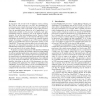Free Online Productivity Tools
i2Speak
i2Symbol
i2OCR
iTex2Img
iWeb2Print
iWeb2Shot
i2Type
iPdf2Split
iPdf2Merge
i2Bopomofo
i2Arabic
i2Style
i2Image
i2PDF
iLatex2Rtf
Sci2ools
PPOPP
2010
ACM
2010
ACM
Thread to strand binding of parallel network applications in massive multi-threaded systems
In processors with several levels of hardware resource sharing, like CMPs in which each core is an SMT, the scheduling process becomes more complex than in processors with a single level of resource sharing, such as pure-SMT or pure-CMP processors. Once the operating system selects the set of applications to simultaneously schedule on the processor (workload), each application/thread must be assigned to one of the hardware contexts (strands). We call this last scheduling step the Thread to Strand Binding or TSB. In this paper, we show that the TSB impact on the performance of processors with several levels of shared resources is high. We measure a variation of up to 59% between different TSBs of real multithreaded network applications running on the UltraSPARC T2 processor which has three levels of resource sharing. In our view, this problem is going to be more acute in future multithreaded architectures comprising more cores, more contexts per core, and more levels of resource sharin...
Distributed And Parallel Computing | Multithreaded Network Applications | PPOPP 2010 | Resource Sharing | UltraSPARC T2 Processor |
| Added | 28 May 2010 |
| Updated | 28 May 2010 |
| Type | Conference |
| Year | 2010 |
| Where | PPOPP |
| Authors | Petar Radojkovic, Vladimir Cakarevic, Javier Verdú, Alex Pajuelo, Francisco J. Cazorla, Mario Nemirovsky, Mateo Valero |
Comments (0)

